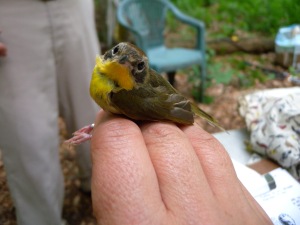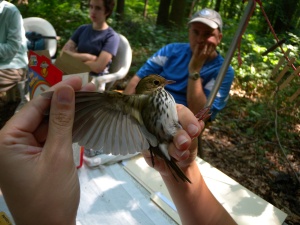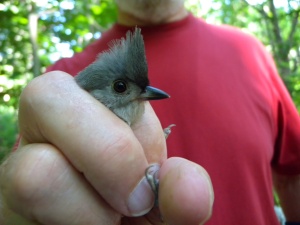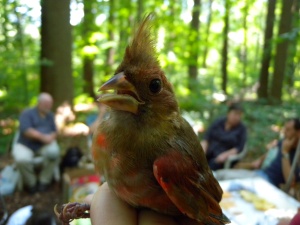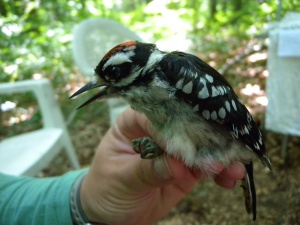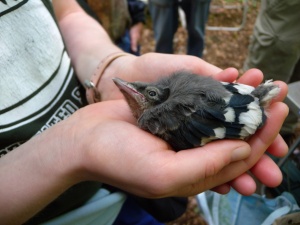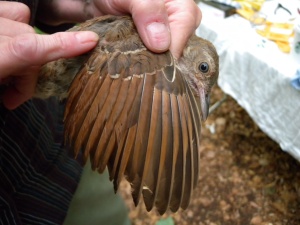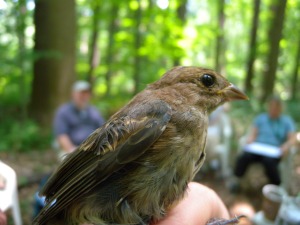
I hope this finds you enjoying the height of your summer and the company of those nosy, gregarious catbirds that have multiplied in your yard! Sadly, they won’t be here for too much longer. Gray Catbirds as well as many of our other favorite summer birds like Wood Thrush, Ruby-throated Hummingbird, Veery, Scarlet Tanager, Eastern Phoebe, and Common Yellowthroat are finished nesting and are now gearing up for their southern voyage. This usually involves molting into their “fall clothes” (depending on the species) and then fattening up for migration. They fill their furcular hollow (the wishbone area) with fat in much the same way as you fill your tank with gas before a long trip!

But enough with migration talk for now…We still have another couple of weeks of summer, according to a bird’s calendar! In fact, there are some birds that are taking their time and still nesting or just finishing up. Goldfinches are among the last North American birds to nest, usually waiting until July or even early August; this is when milkweed, thistle, and other plants produce their fibrous seeds which goldfinches use as nesting material and the main food source for their young. They are strict vegetarians and raise their kids that way too, unlike most other seed-eating avian parents. This is bad news for lazy, young Brown-headed Cowbird moms who think they can get away with shirking their parental duties by dropping off their eggs with goldfinch foster families. Once hatched, cowbird babies in goldfinch nests never survive because the all-seed diet isn’t enough for them.

I also want to fill you in on all of the exciting bird happenings of this past month at Rushton, namely the MAPS babies. MAPS, which stands for Monitoring Avian Productivity and Survivorship, is the most important, data intensive project that a banding station can do. The program was started in 1989 by the Institute for Bird Populations in Point Reyes, CA, and there are now over 500 certified, constant-effort MAPS stations all over North America, including Rushton Woods Preserve as of this summer!
As an official MAPS station, we banded once every 10 days during the breeding season, following strict IBP protocol that ensures that our data can be easily compared to continent-wide data. This involved clearing and setting up 10 new strategic net lanes throughout the preserve, with each net a certain distance apart from the others within an 8 hectare total area. Then we completed a rigorous Habitat Survey Analysis of all the habitat types, plant species, and botanical structural composition of our study area. Banding in the oppressive heat of the summer while trying to ward off ticks and Lyme disease was another challenge, but we enjoyed every minute of it knowing it’s all for the birds! OK, so maybe someone didn’t exactly enjoy the Lyme disease…

Our resulting data will contribute to critical information on the ecology, conservation, and management of North American landbird populations, and the factors responsible for changes in their populations. Check out the IBP website to learn more about MAPS and the other important projects underway as well as their training programs. There, you will also find interesting bird banding resources and publications, including the MAPS annual report.
I’d say Rushton’s first MAPS season was very successful! We have records on 242 birds total, including 138 new birds and 98 recaptures. Many of those recaptures were birds we had caught in one of the previous springs (2010 or 2011) in our migration nets. Other recaptures were birds that had bad luck and got stuck in our ‘webs’ more than once this summer. We recorded a total of 42 species on the Breeding Bird Survey (or BBS, another part of the MAPS protocol); each species was designated as a Confirmed Breeder, Probable Breeder or merely as Observed based on the quality of our observations over the 8 banding sessions.
We are in the process of entering and making sense of our data and will hopefully be able to give you a more comprehensive summary soon! For example, if we analyze the data and find that most of the breeding catbirds were Second Year (SY) birds rather than older adults, this could indicate that the habitat isn’t so great since we know older males get the better territories. In another scenario, if we have all older birds and no returning SY individuals of a neotropical migrant, this could indicate high mortality on the wintering grounds. However, we always need a big picture before we can make such conclusions, which is what continent-wide MAPS data from constant-effort MAPS stations gives us.
We do know that we banded oodles of adorable babies of 16 different species, so 16 of those 42 species on the BBS were without a doubt breeding successfully in Rushton! See if you can identify the species of each of our babies pictured below. Then scroll down for the answers.
Some of the babies are more “babyish” looking than the others, depending on how far along they are in their first molt. You can tell baby birds apart from adults by looking for wispy under-tail coverts and other wispy feathers on the body. Juvenile birds also usually have bare “wing pits” and purple featherless bellies that can be mistaken as brood patches. (A brood patch is a bare belly on adult female birds who pluck their tummy feathers out in order to be better able to monitor and regulate the temperature of their eggs). Another telltale sign of a baby bird is the presence of “bird lips,” which are just yellow fleshy parts on the corners of the bird’s bill that disappear as the bird matures. There are species-specific clues to juvenile bird ID too: thrushes are usually speckled, towhees’ eyes are black and turn red with age, cardinals’ bills start out light and turn red with age, etc.
The species whose baby birds we banded included (in the order pictured above) Wood Thrush, Veery, Common Yellowthroat, Ovenbird, Tufted Titmouse, Northern Cardinal, Downy Woodpecker, Blue Jay, Brown Thrasher, and Indigo Bunting. Did you get them all right? In addition, we banded babies of Eastern Towhee, Eastern Wood Peewee, American Robin, White Breasted Nuthatch, Carolina Wren, and last and most abundant, Gray Catbird. We are proud of our list of babies! Of course, we would be more satisfied if we had Kentucky Warbler (which has been recorded as using Rushton in the past) and/or Louisiana Waterthrush. What could this indicate about our habitat?
Neither of these prized species were seen or heard this summer, although we did band a Louisiana Waterthrush in May during migration. Since we did not catch or hear the waterthrush during MAPS banding, we cannot confirm that they breed here. However, we did hear him singing vigorously this spring, and it is thought that unlike many other warblers, he does not usually sing until he arrives on his breeding grounds. Waterthrush are also known to be early breeders. Named the “feathered trout” of forest streams, the Louisiana Waterthrush is a bio-indicator of water quality because it feeds primarily on aquatic macroinvertebrates, like mayfly larva, that are intolerant to acid pH and pollution. Therefore, the presence of Louisiana Waterthrush in Rushton shows the importance of the protections that the preserve affords to the Indian Run tributary of Ridley. Read more about this special bird in the American Birding Association’s article. Also be sure to check out the accompanying WebExtra with comments by PA ornithologists.

Here’s an interesting birding tip from Cornell Lab of Ornithology: To differentiate between Louisiana and Northern Waterthrush, remember that the pitch of the Louisiana’s song usually descends just as the hilly stream habitat it prefers, while the beginning notes of the Northern’s song stay on the same pitch just like the flat bogs and waters it prefers.
This month, we will be focusing on a different kind of migrant of equal importance, the Monarch butterfly. I’m pleased to announce that in addition to becoming an official MAPS station, Rushton Woods Preserve became an official Monarch Waystation this month! We are on the University of Kansas’ national registry of hundreds of Monarch Waystations that provide milkweeds, nectar plants, and shelter for monarchs throughout their delicate annual cycle of reproduction and migration. This nationwide conservation effort is extremely important because Monarch butterflies are declining due to habitat loss from development, frequent mowing, and widespread use of herbicides in croplands, pastures, and roadsides. Invasive milkweed pests and monarch parasitoids are also threats to the population. It is our duty to do everything we can to ensure that this miraculous migration continues to inspire people of all ages for generations to come.

I encourage you to learn more about and/or participate in some of the citizen science projects for monarch conservation including Monarch Watch through the University of Kansas (migration tagging and waystation certification) and the Monarch Larva Monitoring Project (MLMP) through the University of Minnesota. These projects are fun for children and adults and crucial to monarch research and conservation. You are also more than welcome to come out to Rushton to visit our spectacular Monarch Waystation; the fields are full of Common Milkweed, Monarch adults and larvae, and other flowers and butterflies. Also, please let me know if you or a friend would like to collect data for Rushton for MLMP. Rushton is a certified MLMP site, but we haven’t had the time to monitor! MLMP data is important to understanding how and why monarch populations vary in time and space.
The PA Young Birders meeting this month is Monarch Madness! We will meet at Rushton Farm from 6-7:30 PM on Wednesday August 24. Join us as we explore the fascinating lives of Monarch butterflies and contribute to their conservation. We will be surveying our milkweed patch for Monarch larvae and other interesting creatures that call milkweed home. Afterwards, we will send our citizen science data to the MLMP. There should also be a few migrant Monarch adults around for us to tag for Monarch Watch, although the peak migration is projected to occur around the second week of September for our latitude. Catching Monarchs for tagging is no easy task because they are actually faster than you’d expect, so make sure your children have on their running shoes! Tagging records have been able to show that the overall migration advances only 25-30 miles a day, but some individuals, like one late season monarch flying from Virginia to Texas, can average 61 miles per day!
For a recap and pictures of our last fun PA Young Birders meeting, “Birds and Beaks”, go to Notes from the Wildside, Adrian Binns’ blog!

These days, I’m hearing a change in the night symphony… a subtle crescendo of crickets and a lessening of the cicada choir… Several leaves of the Black Gum tree in my woods have turned a deep red and spicebush berries are ripening… There is a certain crispness to the air here and there, and the birds seem a bit more anxious…. Time to shake the dust off those ‘confusing fall warbler’ guides and wipe your ‘bin’ lenses clear! For our dear old friend, Autumn, is near…
And there’s a lot going on the woods,
~Blake


